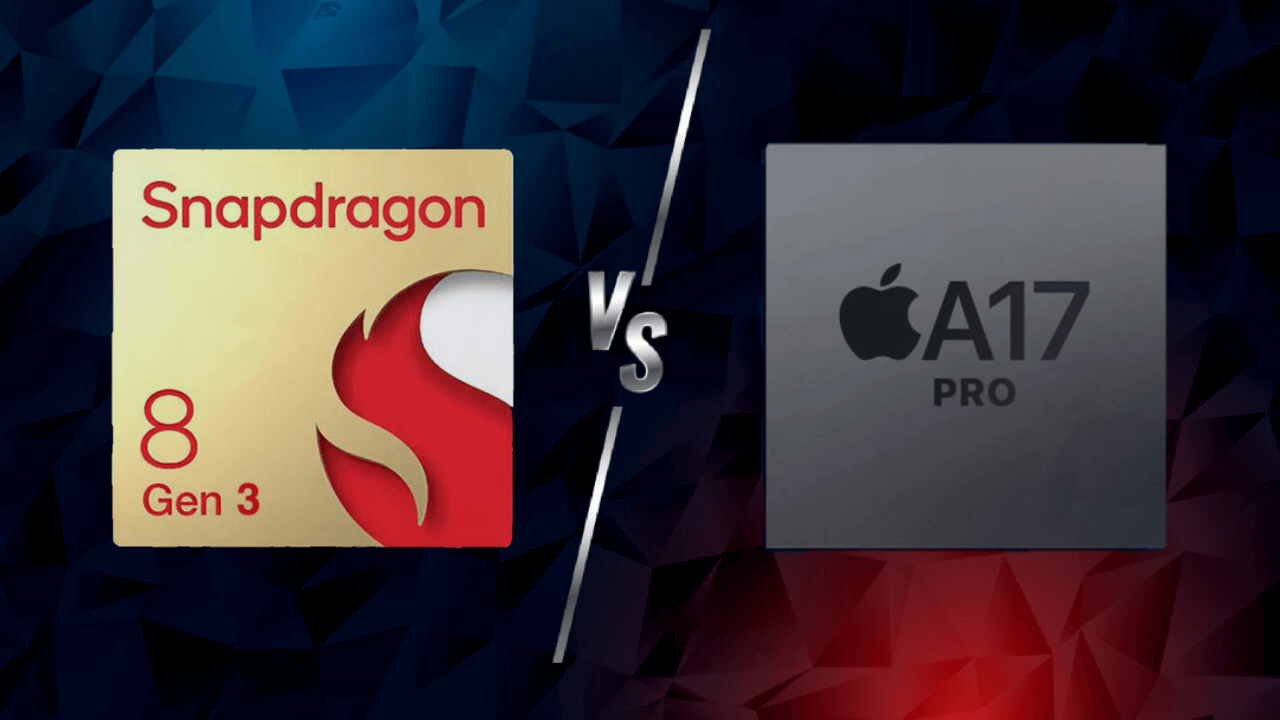Full Review of Snapdragon 8 Gen 3 vs Apple A17 Pro:
Hi guys, today we will discuss the new generation powerful Snapdragon 8 Gen 3 vs A17 Pro Chip. The Snapdragon 8 Gen 3 and Apple A17 Pro represent the latest and greatest mobile processors from Qualcomm and Apple. With powerful upgrades in CPU, GPU, AI, and connectivity, these two chips are pushing the boundaries of what’s possible on smartphones.
But which one reigns supreme? Let’s dive into a detailed comparison of the Snapdragon 8 Gen 3 vs A17 Pro chip.
Pros and Cons Snapdragon 8 Gen 3 vs A17 Pro Chip
Snapdragon 8 Gen 3 Pros:
– Faster CPU performance – Up to 30% over Snapdragon 8 Gen 2
– More powerful Adreno GPU – 25% faster graphics
– Cutting-edge connectivity – WiFi 7, Bluetooth 5.3, 10Gbps USB 3.2
– Highly efficient – 25% better CPU and GPU efficiency
– Octa-core design – Eight cores for maximum performance
Snapdragon 8 Gen 3 Cons:
– Lower single-core performance than A17 Pro
– Lacks Apple’s tight hardware/software integration
A17 Pro Pros:
– Blazing fast single-core performance
– Unmatched neural engine performance
– Excellent energy efficiency
– Seamless iOS optimization
– Consistently high benchmark scores
A17 Pro Cons:
– Less powerful multicore performance vs Snapdragon
– Slower Adreno-rivaling GPU
– Still on WiFi 6E and Bluetooth 5.3
– Lower cellular modem speeds (X70 vs X75)
CPU and Performance
The Snapdragon 8 Gen 3 features an octa-core Kryo CPU with a prime core clocked at 3.2GHz and four performance cores at 2.8GHz. This delivers up to 30% faster CPU performance over the previous generation Snapdragon 8 Gen 2.
Apple A17 Pro has a hexa-core design with two high-performance cores and four efficiency cores. The two performance cores are clocked at an impressive 3.46GHz. However, with two fewer performance cores, the A17 Pro lags behind the Snapdragon 8 Gen 3 in multicore CPU tests.
In Geekbench tests, the Snapdragon 8 Gen 3 scored 1486 single-core and 5344 multi-core. Comparatively, the A17 Pro scored 1874 single-core and 5142 multi-core. So while the A17 Pro has a clear single-core lead, the Snapdragon wins in multicore thanks to its octa-core setup.
Real-world usage is where the Snapdragon’s multicore advantage shines through. The extra performance cores handle demanding workloads better, like gaming, multimedia editing, and multitasking. For most users, the Snapdragon 8 Gen 3’s CPU power is going to feel faster in daily use.
Graphics Performance
The Snapdragon 8 Gen 3 uses the latest Adreno 740 GPU, which Qualcomm claims is 25% faster than the previous generation Adreno 730. Apple says the A17 Pro’s 5-core GPU is up to 20% faster than the A16.
In graphics benchmarks, the two chips trade blows. In GFXBench tests, the Snapdragon 8 Gen 3 scored 237fps in the Aztec Ruins Vulkan test, edging out the A17 Pro’s 224 fps. However in 3DMark Wild Life Unlimited, the A17 Pro takes the lead with 20.7 fps vs 19.9 fps on the Snapdragon.
Real-world gaming is going to be excellent on both. The Adreno 740 and A17 Pro’s GPU can handle the most graphics-intensive mobile games smoothly. High refresh rate QHD+ displays are also supported. You’ll be hard-pressed to notice visual differences between the two.
Overall, the Snapdragon 8 Gen 3 probably has a slight edge for gaming enthusiasts thanks to the beefier Adreno GPU. But for most users, either chip will deliver outstanding mobile graphics.
AI and Neural Engine
Qualcomm’s Hexagon AI engine on the Snapdragon 8 Gen 3 received major upgrades. It’s now up to 4.35x faster than the previous generation according to Qualcomm. Sensory processing, natural language processing, and AI acceleration all see massive improvements.
Apple’s latest 16-core Neural Engine on the A17 Bionic gets a nice bump up in performance as well. Apple says it’s up to 40% faster than the previous generation Neural Engine.
In real-world use, these AI performance leaps enable advanced features like real-time machine translation, intelligent photo editing, enhanced AR capabilities, and much more. The on-device processing helps keep user data secure too.
It’s tough to compare AI performance directly between the Snapdragon and A17 Pro. But both deliver excellent neural processing capabilities that are generations ahead of previous mobile chips. For most consumers, the AI experience will be top-notch regardless of which chip their smartphone uses.
Connectivity
Connectivity is an area where the Snapdragon 8 Gen 3 pulls ahead of the A17 Pro. Qualcomm’s new mobile platform supports the very latest standards including Wi-Fi 7, Bluetooth 5.3, and Snapdragon X75 5G modem.
Wi-Fi 7 boasts up to 2x faster speeds than WiFi 6/6E along with lower latency. Bluetooth 5.3 improves audio quality and LE data transfer speeds. The X75 modem enables staggering 10Gbps 5G peak speeds and 3Gbps average speeds.
Meanwhile, the iPhone 15 Pro with A17 Pro is still on Wi-Fi 6E, Bluetooth 5.3, and the X70 modem (5Gbps peak, 2Gbps average speeds). So in terms of wireless connectivity, the Snapdragon 8 Gen 3 has a leg up.
Efficiency
Both Qualcomm and Apple emphasized power efficiency improvements with these latest chips. The Snapdragon 8 Gen 3 is built on TSMC’s advanced 4nm process node. It has a 25% more efficient CPU and 25% more power efficient GPU compared to the previous gen Snapdragon.
The A17 Bionic is built on TSMC’s cutting-edge 3nm node. Apple says it has the best power efficiency yet for an iPhone chip. The A17 Pro really does shine in battery life tests, slightly outpacing the Snapdragon 8 Gen 2 while managing thermals exceptionally well.
In the end, battery life and performance should be excellent on both processors. The A17 Pro may have a small advantage when it comes to power efficiency, but in real world usage it likely won’t make a huge difference.
Hardware and Software Integration
A key advantage Apple has is its tight integration between hardware and software. iOS is designed from the ground up to take full advantage of each A-series chipset. This allows Apple to optimize performance in ways that Qualcomm can’t match.
Features like ProRes video recording are seamlessly integrated into the iPhone camera app thanks to Apple’s customized silicon. Dynamic Island on the iPhone 14 Pro also showcases this hardware/software synergy.
Since Android is an open platform, Qualcomm has less control over software optimization on Snapdragon-powered phones. There is definitely something to be said for Apple’s vertical integration advantage.
Price and Availability
The Snapdragon 8 Gen 3 is already available in phones like the Samsung Galaxy S23 series. Many other Android flagships in 2023 will also feature Qualcomm’s latest chipset. With wide availability across brands, pricing varies widely too.
The A17 Pro is exclusively available in iPhone 15 Pro models starting at $999. By controlling the entire design process from chip to phone, Apple can justify the premium price for their cutting-edge experience.
If you want the absolute best chip available in an Android phone, the Snapdragon 8 Gen 3 is a great choice with models at every price point. The A17 Pro delivers outstanding performance too but is limited just to Apple’s most expensive iPhones.
Snapdragon 8 Gen 3 vs A17 Pro: Which Is Better?
Overall, the Snapdragon 8 Gen 3 matches or exceeds the A17 Pro in several areas like CPU power, graphics, and connectivity. Qualcomm’s chip also benefits from an octa-core design with better multicore distribution versus Apple’s dual performance core setup. And you’ll get the Snapdragon in far more affordable Android devices too.
However, the A17 Pro still reigns supreme in single-threaded performance and power efficiency. Apple also has an edge when it comes to hardware/software integration. So if you want the absolute best chip in a premium package, the A17 Pro in iPhone 15 Pro models is tough to beat.
Ultimately though, these are the two most powerful and advanced mobile processors ever designed. You really can’t go wrong with either the Snapdragon 8 Gen 3 or A17 Pro. They represent the cutting edge of smartphone performance and deliver an exceptional experience for users.
Frequently Asked Questions:
Which chip has better CPU performance?
The Snapdragon 8 Gen 3 has better overall CPU performance thanks to its octa-core design with more high-performance cores. But the A17 Pro’s two performance cores make it faster in single-threaded workloads.
Which chip is more power efficient?
Early testing shows the A17 Pro having slightly better power efficiency over the Snapdragon 8 Gen 3. But both deliver excellent battery life that outpaces previous generations.
Which processor is better for gaming?
With its more powerful Adreno GPU, the Snapdragon 8 Gen 3 has a slight edge for gaming. But graphics performance is excellent on both chips – mobile gamers will be happy regardless.
When will the Snapdragon 8 Gen 3 be available?
The Snapdragon 8 Gen 3 is already available now in phones like the Samsung Galaxy S23 series. Many more Android flagships in 2023 will feature the new chip.
Does the A17 Pro support WiFi 7?
No, the iPhone 15 Pro with A17 Pro still uses WiFi 6E. Only the Snapdragon 8 Gen 3 supports the latest WiFi 7 standard for faster speeds.
Which chip has better AI capabilities?
Both the Snapdragon 8 Gen 3 and A17 Pro have extremely powerful AI and neural engines. They both deliver huge performance leaps that enable advanced on-device AI experiences.




